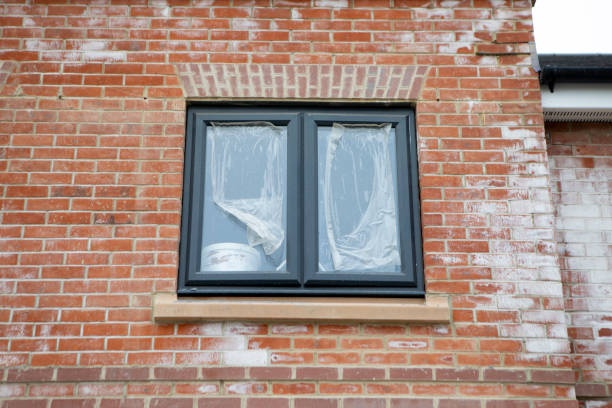When it comes to maintaining your building’s structural integrity, window lintels often go unnoticed. These crucial components are responsible for supporting the weight above windows and doors. However, over time, lintels can become damaged, leading to significant structural problems if not addressed promptly. In this blog, we’ll explore how window lintel damage can lead to costly repairs and what you can do to prevent these issues.
What is a Window Lintel?
A window lintel is a horizontal support beam located above a window or door that bears the load of the wall or structure above it. Lintels are typically made from materials like steel, concrete, or stone, depending on the building’s construction. They help distribute weight and prevent the window frame from collapsing under the pressure of the building. Learn in detail about window lintels by clicking here.
Signs of Window Lintel Damage
Before understanding the consequences of lintel damage, it’s essential to recognize the early signs. Some common indicators include:
Do you want to visit Haridwar? travel agents in Haridwar is the right place to plan your tour. You can book your tour from here.
- Cracks Above Windows: Horizontal or diagonal cracks forming around the windows often point to lintel issues.
- Sagging Windows or Doors: A noticeable sag in the window frame or door could be a sign of a failing lintel.
- Rust Stains: Rusting is common in steel lintels, and visible rust stains can indicate the lintel is corroding.
- Water Leaks: Damaged lintels can allow water to seep into the structure, leading to water damage.
Ignoring these signs can lead to larger structural problems down the road, so it’s important to take action early.
How Lintel Damage Can Lead to Structural Problems
1. Cracking and Shifting Walls
When a window lintel becomes damaged or weak, it fails to properly support the weight of the building material above the window or door. This imbalance causes excessive pressure on the surrounding walls, leading to cracks and shifting. Here’s how this unfolds:
- Formation of Cracks: As the lintel loses its ability to hold the weight, the walls around it may develop cracks. These can be horizontal, diagonal, or even vertical cracks above the windows. Initially, they may seem minor, but over time, they grow and worsen, jeopardizing the building’s structural stability.
- Shifting of the Wall: The cracks may cause the wall to shift or bulge, making the entire structure unstable. This movement can disrupt the alignment of windows and doors, causing them to stick, jam, or fail to close properly.
- Aesthetic and Structural Consequences: Not only do the cracks and shifting affect the appearance of the building, but they also weaken the overall structural integrity, creating safety hazards for occupants. If left unattended, this damage can lead to partial wall collapses, which require extensive repairs.
2. Water Damage and Mold Growth
Another major consequence of damaged lintels is water infiltration. Since lintels are typically part of the exterior envelope of a building, their failure creates pathways for moisture to enter. This can result in:
Do you want to visit char dham? char dham tour operator is the right place to plan you Char Dham tour. You can book you tour from here.
- Water Seepage: As cracks form in and around the damaged lintel, water from rain, snow, or ice can seep through. The moisture can permeate the wall, affecting not just the lintel but also the masonry or other wall materials. Over time, this water can cause further degradation of the surrounding structure, such as rusting steel lintels or deteriorating concrete and brick.
- Compromised Interior Structures: Water that enters through the cracks can affect not only the exterior wall but also the building’s interior. This may result in damage to plaster, drywall, insulation, and wooden structural components, causing rot and decay.
- Mold and Mildew Growth: Continuous moisture infiltration creates a perfect environment for mold and mildew growth. Mold poses serious health risks, especially for people with allergies or respiratory conditions, and mold remediation can be both time-consuming and costly. Additionally, mold can damage the integrity of walls, insulation, and other materials, compounding the repair costs.
3. Foundation Damage
Though lintels are situated above windows and doors, the damage they sustain can have far-reaching effects on the entire structure, including the foundation:
- Uneven Load Distribution: When a lintel is compromised, it can no longer distribute the load evenly across the structure. This uneven distribution of weight causes additional stress on other parts of the building, including the foundation.
- Cracks and Settlement Issues: As the walls shift or crack due to lintel damage, the foundation beneath the building can also become compromised. The pressure from above can lead to cracks in the foundation or cause the foundation to settle improperly. Over time, this can result in sinking floors, wall cracks, and severe structural instability that may require significant foundation repairs.
- Increased Repair Costs: Foundation repairs are often some of the most expensive home maintenance issues to address. Left unchecked, the lintel damage that leads to foundation issues can result in extensive renovations, such as leveling the foundation or rebuilding parts of the structure.
4. Increased Energy Costs
While structural issues are the most obvious problems caused by lintel damage, the impact on energy efficiency is often overlooked. Here’s how lintel damage affects your building’s energy performance:
- Loss of Insulation: Damaged lintels and the cracks that result can disrupt the insulation around your windows. Gaps and cracks allow drafts to enter your building, making it more difficult to maintain a consistent indoor temperature.
- Heating and Cooling Strain: Drafts and temperature fluctuations force your heating and cooling systems to work harder to maintain comfort. This increased demand on HVAC systems can lead to higher energy bills and reduced efficiency.
- Escalating Energy Costs: Over time, the increased energy usage caused by lintel damage can add up. Addressing these insulation issues early through proper lintel repair can help keep energy costs in check and improve overall building efficiency.
Why Lintel Repairs Are More Cost-Effective Than Waiting
Repairing damaged window lintels early on is far more cost-effective than waiting for larger structural problems to arise. Here’s why:
- Prevent Further Damage: Addressing lintel issues early prevents further deterioration of the building’s structure, saving you from costly foundation or wall repairs.
- Avoid Safety Hazards: Cracked or shifting walls pose safety risks for occupants. By fixing lintel problems promptly, you reduce the chances of structural collapse or injuries.
- Lower Repair Costs: Small lintel repairs or replacements are relatively inexpensive compared to the cost of fixing foundation issues, wall replacements, or water damage repairs.
How to Prevent Window Lintel Damage
Preventing window lintel damage requires regular inspection and maintenance. Here are some steps you can take:
- Inspect Regularly: Schedule regular inspections of your window lintels to check for signs of wear or damage. Look for cracks, rust, or any sagging around the windows.
- Address Water Issues: Ensure proper drainage and waterproofing to prevent water from seeping into the lintels. Consider installing flashing to direct water away from the windows.
- Hire Professionals: If you notice any signs of lintel damage, it’s crucial to hire professionals for repairs. Attempting a DIY fix could worsen the problem and lead to costly mistakes.
Conclusion
Window lintel damage may seem like a minor issue at first, but it can quickly escalate into serious structural problems if left unaddressed. From cracking walls and water damage to foundation issues and energy inefficiency, the consequences of ignoring lintel problems are vast. Regular maintenance, early repairs, and professional intervention are key to ensuring the long-term safety and stability of your building.
Home


